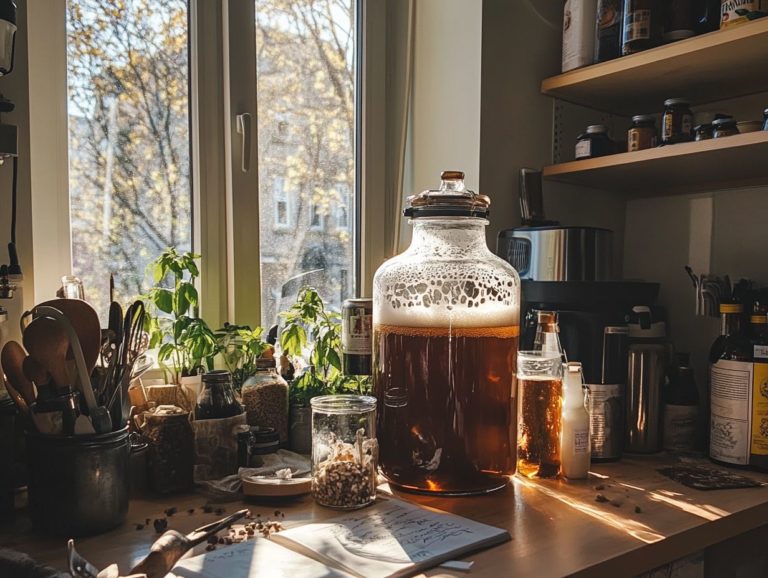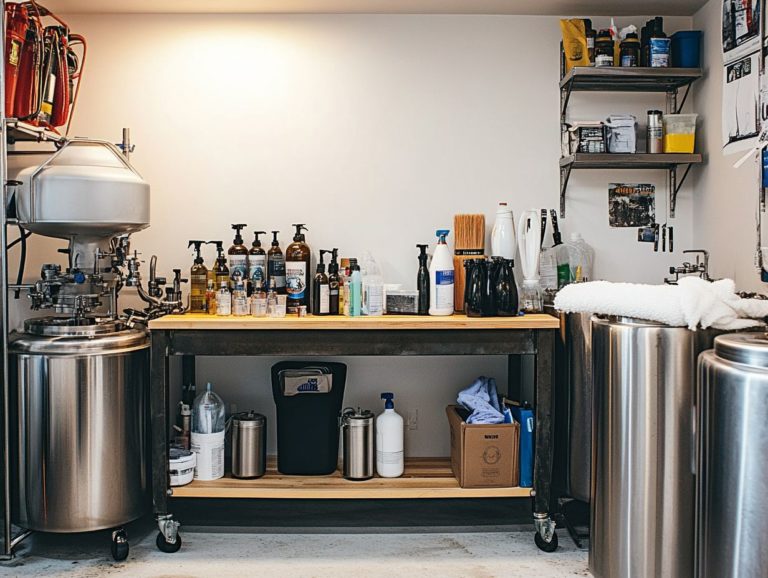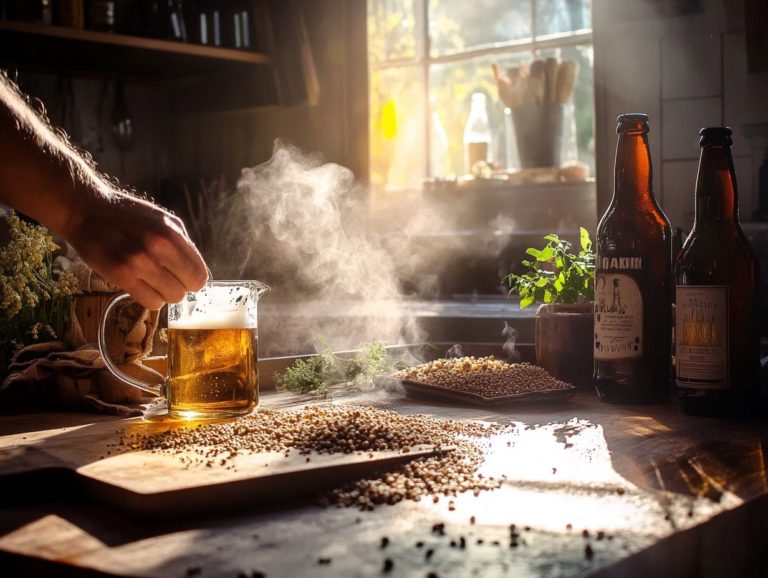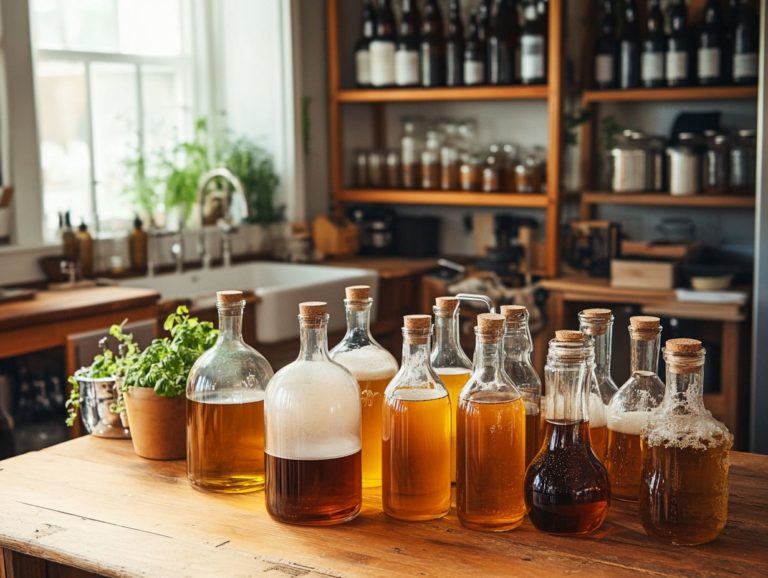How Can I Avoid Infection in My Beer?
Beer brewing is a delicate art. One significant challenge is infection, which can compromise the quality and taste of your final product.
Whether you re just starting out or you ve honed your craft, understanding the causes of beer infection is essential. This includes infections caused by bacteria and wild yeast strains.
Dive into this article to discover common types of beer infections and how you can prevent them effectively. You’ll find practical tips to protect your brew, such as monitoring the fermentation process and sanitizing equipment.
Contents
- Key Takeaways:
- What Causes Infection in Beer?
- How Can I Tell If My Beer is Infected?
- Tips to Keep Your Beer Infection-Free During Brewing
- What Are the Best Practices for Sanitizing Equipment?
- What Are the Key Steps to Preventing Infection During Fermentation?
- How Can I Prevent Contamination in My Beer During Bottling?
- What Should I Do If My Beer is Infected?
- When Should I Discard an Infected Batch of Beer?
- How Can I Prevent Infection in My Beer During Storage and Serving?
- What Are the Best Practices for Storing and Serving Beer?
- How Can I Protect My Beer from Contamination at Events or Parties?
- Frequently Asked Questions
- What steps can I take to prevent infection in my beer?
- Can using contaminated water lead to infection in my homebrew?
- How can I tell if my homebrew is infected?
- Is there a specific type of yeast or bacteria that is more prone to causing infection in beer?
- Can infection in my homebrew be harmful to consume?
- Are there any preventative measures I can take during the brewing, bottling, or kegging process to avoid infection?
Key Takeaways:
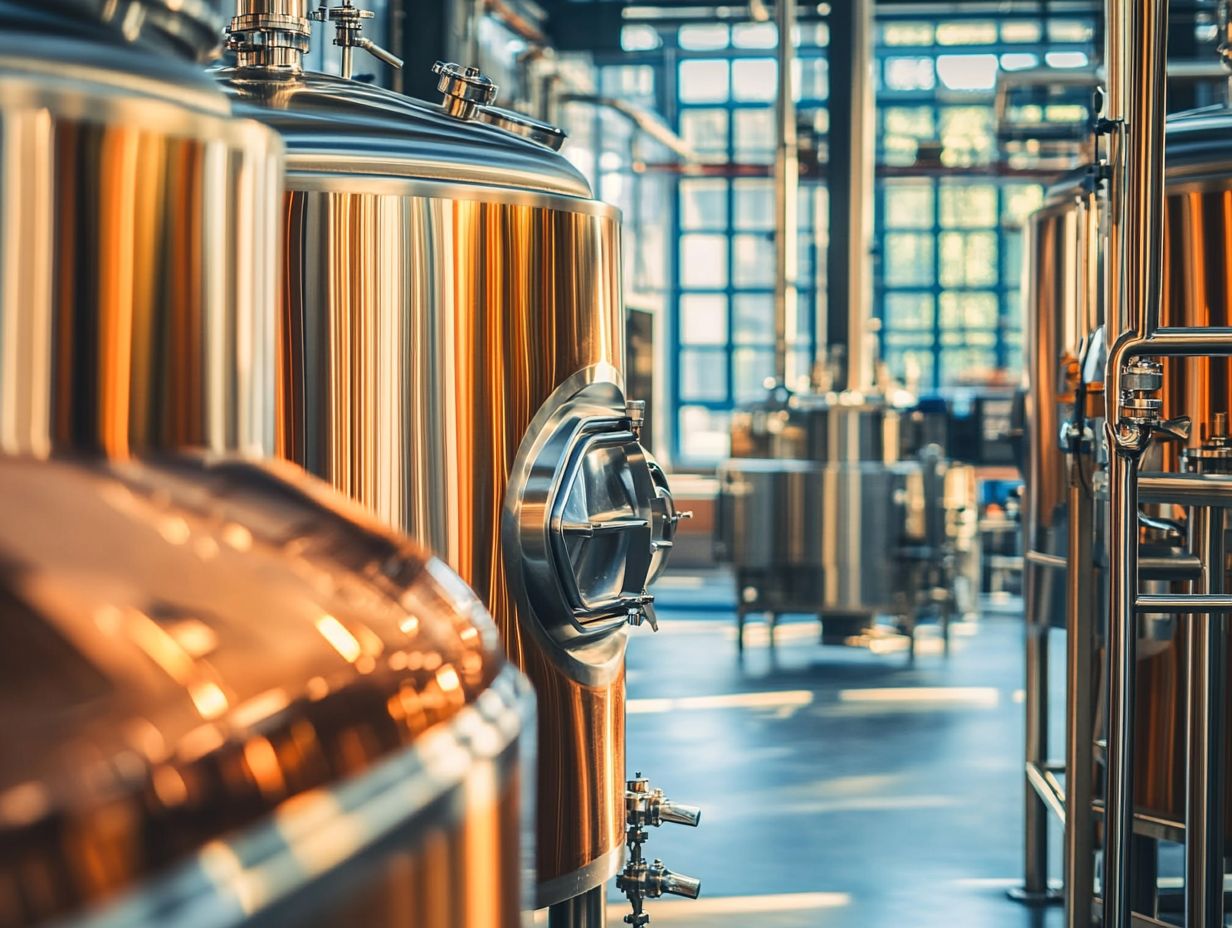
- Regularly sanitize equipment to prevent infection from bacteria and wild yeast during brewing.
- Look for signs of infection, such as off-flavors or unusual odors, to catch issues early.
- Clean and sanitize bottles properly to maintain quality during storage.
What Causes Infection in Beer?
Infection in beer poses a significant challenge for both novice and seasoned brewers. It jeopardizes the quality, taste, and alcohol content of their cherished craft creations.
Various microorganisms, particularly bacteria and wild yeast strains like Lactobacillus and Brettanomyces, can infiltrate the brewing process. This can lead to undesirable off-flavors, aromas, and affect the visual appearance of your beer.
These infections can manifest in numerous ways, from sour flavors to unpleasant smells that compromise the experience of drinking your beer.
What Are the Most Common Types of Beer Infections?
Common beer infections are largely caused by specific strains of bacteria and wild yeast. Understanding these strains is essential for brewing authentic sour beers or avoiding unwanted infections.
For instance, Lactobacillus is known for imparting a delightful sourness and complexity to brews. Brettanomyces, or ‘Brett’ for short, brings in funky, earthy notes that many craft beer aficionados savor. If you’re keen on brewing authentic sour beers, understanding these strains, including Pediococcus, is essential.
The appearance of a film, known as a pellicle, on the beer s surface can sometimes indicate these types of infections. Each microorganism plays a unique role in the brewing process, shaping the overall flavor profile and aroma of the beer.
The lactic acid produced by Lactobacillus is vital for the souring process, lending that tangy finish often sought in styles like Berliner Weisse or Gose. On the flip side, Brettanomyces can add intriguing layers of complexity, with flavors reminiscent of barnyards or tropical fruits.
However, while Pediococcus can create a creamy mouthfeel and introduce buttery notes, it s generally avoided due to the risk of unwanted diacetyl production. The presence of trub in the fermenter can sometimes encourage these organisms to grow.
By grasping the effects of these microorganisms, you can harness the characteristics of wild yeast and bacteria with intention, elevating your brewing craft while minimizing the chances of mishaps.
How Can I Tell If My Beer is Infected?
To determine if your homebrew has been infected, observe its appearance and smell. Look for off-flavors that indicate potential issues.
Look out for common indicators such as:
- an unusual foam often referred to as krausen
- a thick layer of foam
- slimy films known as pellicles that can form on the beer’s surface
You might also notice off-flavors, which can present as sourness or vinegar-like qualities. Excessive bubbling could also indicate unwanted microorganisms at play.
Spotting these signs can save your brew and ensure it tastes fantastic!
What Are the Signs and Symptoms of a Beer Infection?
The signs and symptoms of a beer infection can vary widely. Key indicators can help you determine if your brew has been compromised. You might notice unpleasant off-flavors that present as sour or vinegary notes particularly unwelcome in certain beer styles.
Visual cues, such as a slimy film forming on the surface or excessive bubbling during fermentation, can signal unwanted microbial activity that threatens the integrity of your beer.
Infection can also manifest through unusual aromas, like funky or barnyard-like scents, often stemming from wild yeasts or bacteria. These unexpected traits not only alter the flavor but may also impact the way it feels in your mouth, resulting in a slick or watery texture, detracting from the safety and enjoyment of your beer.
If you see sediment building up at the bottom of the bottle or keg, that could indicate spoilage organisms, affecting clarity and overall presentation. Both breweries and homebrewers should remain vigilant, as these symptoms can significantly influence the drinkability, shelf-life, and enjoyment of the final product. Keeping an eye on the development of bubbles during fermentation can help in the early detection of infections.
Tips to Keep Your Beer Infection-Free During Brewing
Avoiding infection in your beer during the brewing process is essential for achieving a high-quality final product. It starts with rigorous sanitation practices at every stage, from handling ingredients to maintaining clean equipment.
Keeping your equipment impeccably clean is paramount; even the smallest residue of yeast sediment or leftover ingredients can become a breeding ground for unwanted bacteria and yeast, leading to infection. Furthermore, pay close attention to the fermentation environment maintaining the right temperature and ensuring that all ingredients, including specific malts like Maris Otter or hops like Citra, are thoroughly sanitized will greatly minimize the risk of microbial contamination.
This diligence guarantees a safe and enjoyable brewing experience, allowing you to savor the fruits of your labor with confidence.
What Are the Best Practices for Sanitizing Equipment?
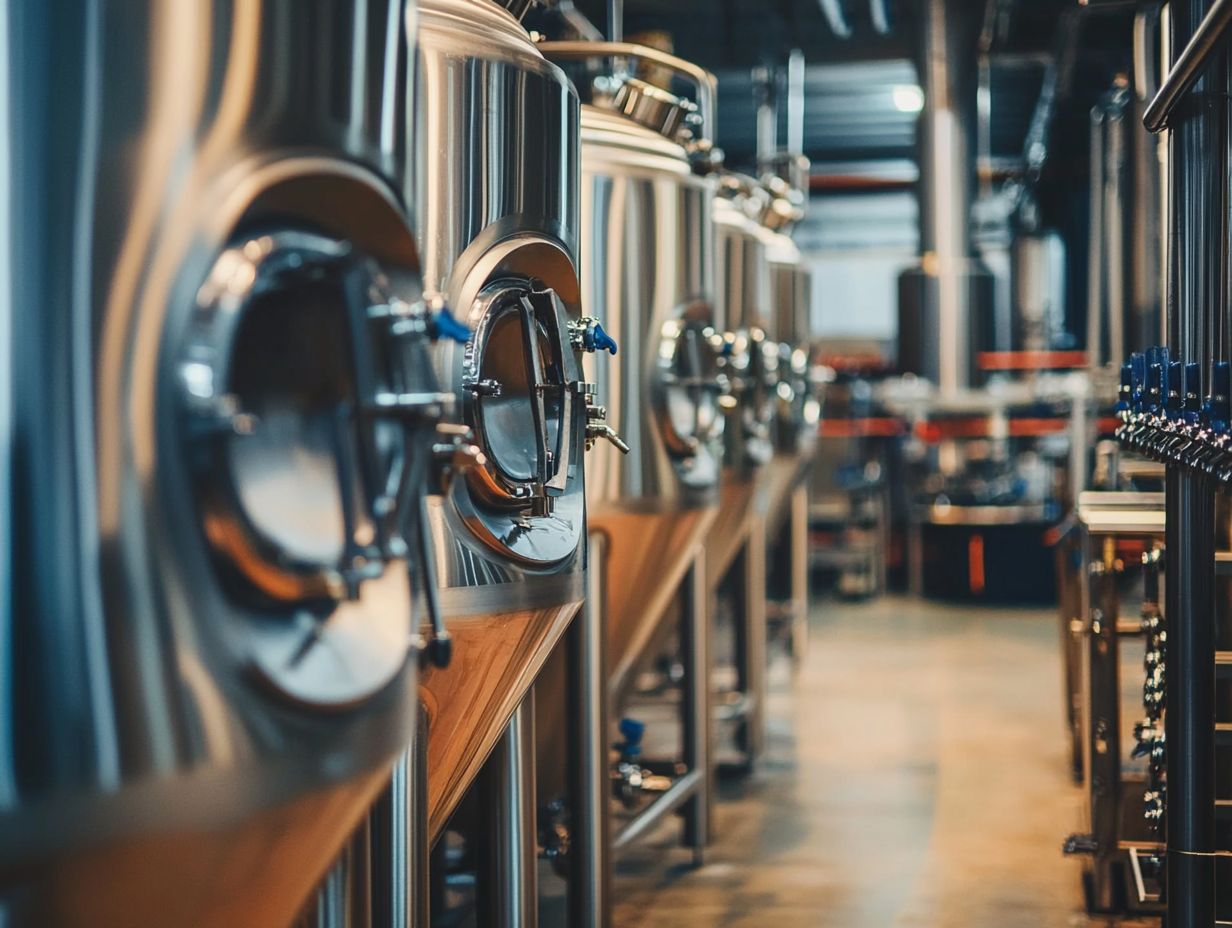
Sanitizing your equipment is one of the most critical steps in the brewing process to prevent infections. Utilizing effective sanitizers like Star-San can significantly enhance your brewing experience.
By ensuring that items such as fermentation buckets, bottles, and utensils are thoroughly sanitized while also keeping an eye on the cleanliness of your plastic equipment, you ll eliminate potential contaminants. This allows you to focus entirely on the art of brewing.
It s essential to follow the manufacturer’s instructions regarding proper use and concentration levels. Doing so will maximize the effectiveness of your sanitation efforts and maintain the quality of your brew.
Sanitation is extremely important, as even the tiniest germs can spoil an entire batch of beer. To achieve optimal sanitation, start by cleaning all your equipment with hot water and a suitable cleaner to remove any residues.
A thorough rinse is crucial before you apply your chosen sanitizer. While different sanitizers, like iodine-based solutions and chlorine bleaches, can also be effective, they require specific application techniques and exposure times to ensure that all surfaces, including those of your fermenter and brewing equipment, are treated adequately.
Pay special attention to areas that tend to collect residue, such as the tap or spigot. Consider using a spray bottle to manage those hard-to-reach spots. By incorporating these steps into your brewing routine, including the maintenance of clean equipment, you ll be able to create delicious homebrews with confidence, knowing that your sanitation practices are spot on!
What Are the Key Steps to Preventing Infection During Fermentation?
To prevent infection during fermentation, focus on several key steps that will effectively safeguard your beer from unwanted microbial activity. Maintaining the optimal fermentation temperature is crucial; fluctuations can create a breeding ground for infections, affecting both the flavor and quality of the final product.
Regularly sanitizing all tools and equipment involved in the fermentation process, such as your fermenter, is essential to mitigate the risks posed by bacteria and wild yeast. This diligence allows you to achieve the best possible results in your brewing endeavors.
Effective temperature control enables your yeast to thrive, promoting healthy fermentation while significantly reducing the likelihood of spoilage. By closely monitoring specific gravity and other indicators, such as the development of foam (krausen), you can track fermentation activity and catch any deviations before they escalate into issues.
Implementing best practices such as maintaining a clean brewing environment and utilizing appropriate fermentation vessels will further elevate the quality of your final product. Adhering to these strategies ensures that the flavors remain true to style, minimizes the chances of unpleasant off-flavors and aromas, and ensures the safety and enjoyment of your beer, which is essential for any aspiring brewer.
How Can I Prevent Contamination in My Beer During Bottling?
Preventing contamination during the bottling process is essential for preserving the integrity of your beer. This stage can introduce unwelcome microorganisms that undermine both flavor and quality. By ensuring that all bottles and bottling equipment are meticulously cleaned and sanitized before use, and managing proper carbonation and ABV levels, you can greatly diminish the risk of infection.
Taking the time to implement proper bottling techniques and adhere to safety protocols will not only enhance your bottling experience but also safeguard the unique characteristics of your homebrew. This way, you can savor the fruits of your labor with pride!
What Are the Best Practices for Cleaning and Sanitizing Bottles?
Cleaning and sanitizing your bottles is an essential step in the brewing process. Any lingering residue can lead to potential contamination of your beer. To ensure the best results, you should thoroughly wash your bottles with hot, soapy water. Rinse them well to eliminate any detergent residue before applying a sanitizer like Star-San.
It’s crucial to make sure each bottle is completely dry before filling. This prevents any unwanted dilution or contamination that could compromise the quality and enjoyment of your craft beer.
To kick off the cleaning process, gather all the necessary supplies. This includes a bottle brush, a clean sink, and your chosen sanitizing solution. Start by soaking the bottles in hot water to loosen any stubborn residue. Then, give them a good scrub with the bottle brush, ensuring every surface is pristine.
Once rinsed, perform the sanitization step while the bottles are still wet. This maximizes the effectiveness of your sanitizer. According to brewing experts, allow the sanitizer to sit for 1-2 minutes, following the manufacturer’s instructions, to effectively eliminate any lingering bacteria.
Finally, placing the bottles upside down on a clean surface will help them dry thoroughly. This sets you up for a successful bottling day.
How Can I Ensure Proper Carbonation to Prevent Infection?
Ensuring proper carbonation in your beer is essential not just for flavor and mouthfeel. It’s also crucial for preventing infection during the bottling and aging processes. By meticulously measuring the amount of sugar you add for carbonation and confirming that healthy yeast is present, you create an environment where carbon dioxide production thrives without inviting unwanted germs.
This delicate balance is vital for maintaining the quality of your brew and enhancing your overall drinking experience. The importance of these carbonation techniques cannot be overstated; even slight miscalculations can result in off-flavors or, worse, spoilage.
Monitoring yeast health is equally crucial. Robust yeast can effectively ferment the sugars, ensuring optimal carbonation while minimizing the risk of contamination from harmful bacteria or wild yeasts during fermentation.
By paying close attention to these elements, you achieve the desired level of fizziness and protect your creations from potential infections. This leads to a successful and enjoyable batch every time.
What Should I Do If My Beer is Infected?
When you discover that your beer has become infected, it s crucial to evaluate the situation meticulously. This will help you decide on the best course of action, as not all infections are created equal.
In some instances, you may find that a batch is still salvageable. This offers you the opportunity to make creative adjustments to its flavor profile. However, there are times when the wisest decision is to discard the infected beer entirely to protect the integrity of your brewing experience.
By understanding the specifics of the infection, you can navigate this challenging situation with confidence and finesse.
How Can I Salvage an Infected Batch of Beer?
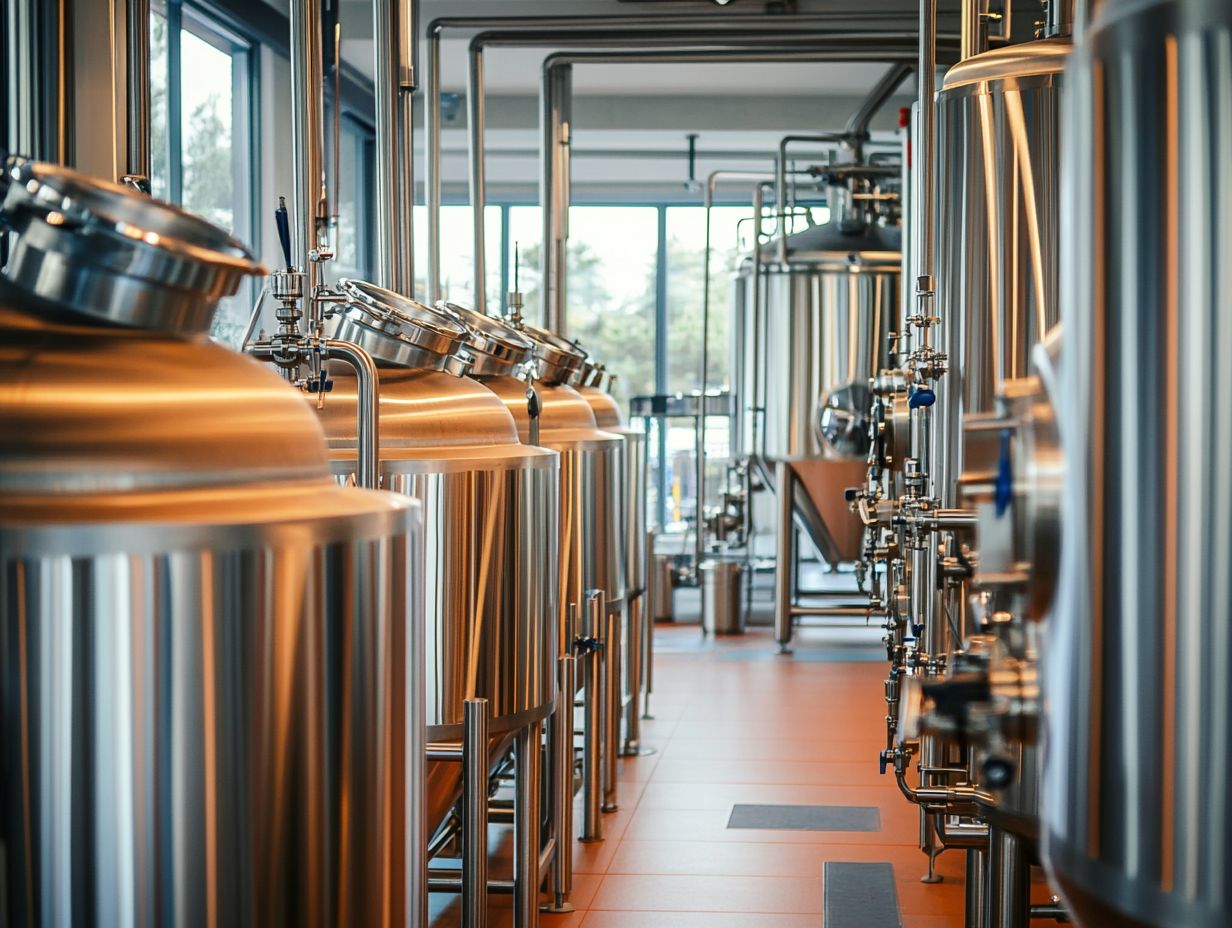
Salvaging an infected batch of beer is often within your reach. Especially when you can pinpoint the type of infection, you can adjust the flavors and overall composition of your brew accordingly.
If wild yeast strains have introduced an unwelcome funkiness, consider adding a controlled amount of fresh hops. This can infuse vibrant floral notes that effectively mask those undesirable flavors. Processing options, such as adjusting carbonation whether through natural or forced methods can also enhance the mouthfeel and acidity.
Should you encounter an infection that results in overly phenolic or medicinal flavors, think about incorporating specialty malts or adjuncts like fruits or spices. These ingredients can work wonders in creatively transforming the final profile of your beer.
Each type of infection presents a unique opportunity to explore new taste horizons. Turning a potential disaster into a delightful new craft beer experience is within your grasp!
When Should I Discard an Infected Batch of Beer?
Knowing when to discard an infected batch of beer is an essential skill you must master as a brewer. Some infections can pose health risks or lead to flavors that are simply unpalatable. If your beer starts showing strong vinegar-like characteristics or emits an off-putting smell, it’s wise to err on the side of caution and discard that batch. This choice often hinges on the severity of the off-flavors and whether they align with your brewing goals.
You should also be vigilant about visual cues. Look out for unusual cloudiness, floating debris, or a thick film on the surface, as these can indicate microbial activity (the growth of microorganisms that can spoil beer) that jeopardizes the quality of your brew. Infections may manifest not just in taste but also through undesirable aromas a sour or musty scent that clashes with the intended flavor profile.
Recognizing these warning signs is crucial for maintaining the integrity of your crafted beers and ensuring the safety of your consumers. Whether you conduct preemptive testing or promptly assess changes in flavor and aroma, managing the risk of infection is a vital component of successful brewing.
How Can I Prevent Infection in My Beer During Storage and Serving?
Preventing infection in your beer during storage and serving is essential for preserving both the quality and taste of your brew. Microbial contamination can rear its ugly head at any stage of the process.
To minimize these risks, it is vital to meticulously clean and sanitize all storage containers and serving equipment before use. Also, maintaining optimal storage conditions like controlling temperature and shielding your beer from light will further protect it from potential infections. This ensures a delightful drinking experience every time.
What Are the Best Practices for Storing and Serving Beer?
Implementing best practices for storing and serving beer is essential for maintaining the quality and freshness of your brew. This ensures that both you and your guests enjoy every sip. Start by keeping your beer in a cool, dark place, away from direct sunlight.
Make it a point to ensure that bottles and kegs are clean and sanitized before filling them. This meticulous attention to detail will help prevent infection, as outlined in 5 tips for avoiding infection in home brew, and contamination, allowing the true flavors and aromas of your beer to shine.
The ideal storage temperature typically hovers between 45 F and 55 F for most beer styles. Lighter beers might thrive at slightly cooler temperatures. Avoiding temperature fluctuations is crucial; they can lead to off-flavors and spoilage definitely not what you want for your carefully crafted brew.
In terms of serving, ensure your glasses are not only clean but also adequately chilled to enhance the drinking experience. Pour with care to achieve that perfect head, allowing the delightful aromas to escape and fill the air.
And don t forget about sanitation. Wash your hands thoroughly and use clean utensils to maintain the integrity of your beer. By following these storage and serving tips, you ll significantly elevate the enjoyment of your brew.
How Can I Protect My Beer from Contamination at Events or Parties?
Protecting your beer from contamination at events or parties is crucial for preserving its quality. This ensures that everyone has a delightful drinking experience. To achieve this, you’ll want to keep all serving equipment think taps and glasses clean and sanitized before use.
Serving beer in a controlled environment that minimizes exposure to heat and light will help maintain flavor integrity and prevent any pesky microbial activity from compromising your brew. Implementing a strict cleaning regimen before and after serving can greatly reduce the risk of contamination.
Any residue left on equipment can be a breeding ground for harmful bacteria, and you definitely don t want that. Another effective strategy is to train your staff on proper pouring techniques to minimize foam and reduce oxidation.
Designating a specific area for beer storage, away from food items, can also help avoid cross-contamination. Regularly monitoring serving temperatures is key; beers should ideally be served at their recommended temperatures to enhance their taste profile while keeping spoilage at bay.
By prioritizing these practices, you can ensure that your attendees enjoy a fresh and safe drinking experience.
Frequently Asked Questions
By applying these tips, you ll enjoy a better brewing experience and share memorable moments with friends and family over great beer!
What steps can I take to prevent infection in my beer?
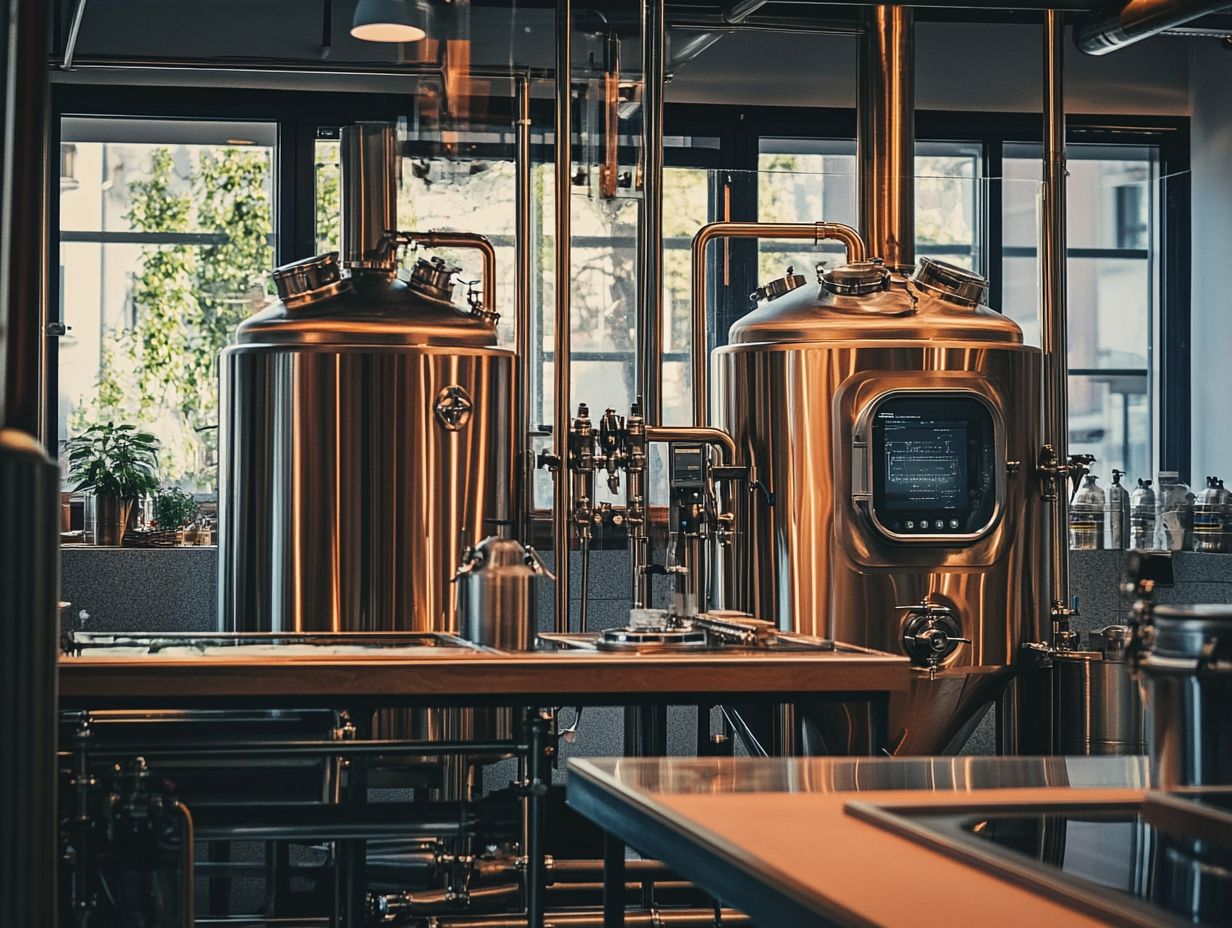
To avoid infection in your beer, first make sure that all of your equipment and containers are clean and sanitized before use. Additionally, use high-quality ingredients and monitor temperature and pH levels during the brewing process.
Can using contaminated water lead to infection in my homebrew?
Yes, using contaminated water can introduce harmful bacteria or other microorganisms like Lactobacillus and Pediococcus into your homebrew, leading to infection. It is important to use clean, filtered water and sanitize all equipment when brewing to avoid this issue.
How can I tell if my homebrew is infected?
Signs of infection in beer can include off-flavors, unusual odors, cloudiness, pellicle formation, and changes in appearance. If you notice any of these signs, it is best to dispose of the batch to avoid potential health risks. Infection by wild yeast or bacteria like Lactobacillus can lead to sour or vinegar-like tastes.
Is there a specific type of yeast or bacteria that is more prone to causing infection in beer?
There are certain strains of yeast and bacteria that are known for being more susceptible to causing infection in beer, such as Brettanomyces and Lactobacillus. It is important to properly research and select the appropriate yeast for your desired beer style, and to use clean equipment to maintain beer quality.
Can infection in my homebrew be harmful to consume?
Infection in beer can lead to potential health risks, especially for those with weakened immune systems. Infected beer can contain harmful bacteria and yeast byproducts that affect the alcohol content and taste. It is best to dispose of any infected batches to avoid any potential hazards.
Are there any preventative measures I can take during the brewing, bottling, or kegging process to avoid infection?
Yes, be sure to properly clean and sanitize all equipment and containers before bottling or kegging your beer. Using sanitizers like Star-San can help ensure clean equipment. It is also important to store the bottles or kegs in a cool, dark place to prevent any potential contamination. Additionally, maintaining proper temperature control during the fermentation process can improve the quality and safety of your homebrew.

